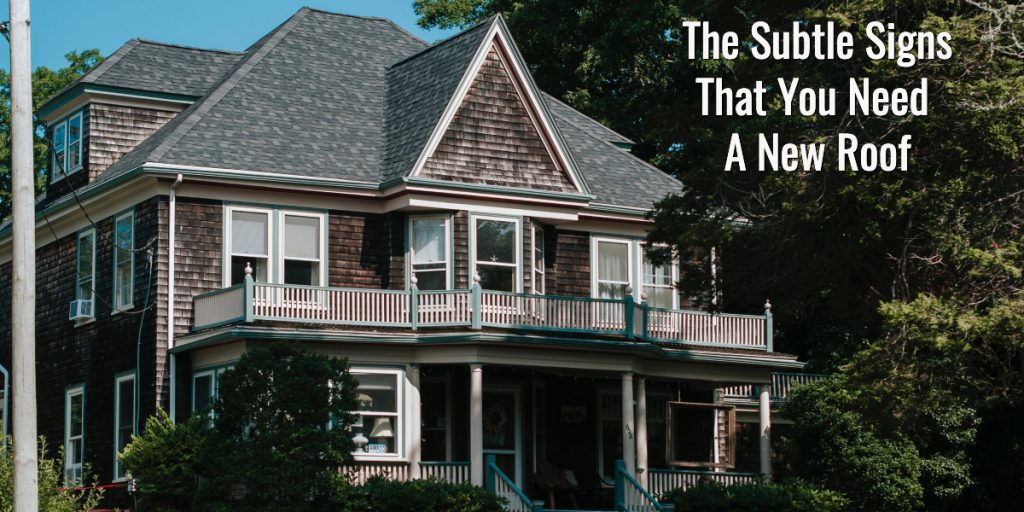A durable roof is one of the most essential, protective components of a home.
And noticing the subtle signs that you need a new roof can keep your family safe.
Faulty roofs commonly result in water getting into the home, which can destroy the drywall, carpet, wood, and personal belongings. The moisture also promotes mold growth, which can be hazardous to the home’s inhabitants.
Even a small leak can cost thousands of dollars in damages. It’s best to be proactive and know when to replace the roof before disaster strikes.
Sometimes the signs that a roof is deteriorating are not blatantly obvious. It’s crucial to be aware of the more subtle indicators.
Inspect Your Roof In The Spring and Fall
At least twice a year, perform a thorough inspection of the outer exterior of the roof. Be on the lookout for missing or damaged shingles.
If the roof has even one missing shingle, this can be a warning that the tar strips are wearing out. This is caused by repeated exposure to the elements and granule loss.
Shortly after, the roof will likely lose more shingles and increase the chances of serious water damage to the home.
Damaged shingles are a major warning sign that the roof is nearing the end of its life. Prolonged sun exposure causes the asphalt layers within the shingle to break down, thus warping its shape.
Weakened shingles tend to coil onto themselves and take on a curled appearance. Curled shingles are likely to catch a gust of wind and fly off. This leaves an exposure for water to eventually leak into the house.
Shingles with cracks are also more susceptible to blowing away, and serious cracks can allow water to seep into the home.
Spots On The Shingles
During biannual inspections, it is also important to look for shingles with dark spots. Discoloration indicates that the shingles are losing granules.
Granules shield the roof’s asphalt layers from being weakened or deteriorated by the sun’s UV rays. Shingles that lose a large portion of their granules leave the asphalt unguarded and vulnerable to rapid erosion.
Aside from discoloration, another sign of granule loss is brittleness and frailty of the shingles. Shingles in this condition often have slight cracks that only worsen with time. Eventually, this will lead to water damage.
Fungal Growth On Shingles
While inspecting the roof’s color, also look for apparent signs of plant or fungal growth, as this also results in discoloration. Organism growth on shingles is a warning sign that water is building up on areas of the roof instead of being repelled.
A moist roof results in an environment that is conducive for the growth of moss, mold, lichen, and algae. Moss and mold may result in loosened shingles, so removal is always required. It may be best to hire a professional, as some organism growths can lead to a very slippery roof.
Don’t Forget The Attic
In addition to inspecting the roof’s exterior, it is also pivotal to inspect the highest point inside the home, which is often an attic.
Look around the attic for dark blotches, water spots, or any damp areas. Compromised roofs usually have an effect on the attic before the rest of the home.
There could be shingle damage, or the underlayments may be worn out. Underlayments are supposed to protect against leaks and usually consists of tar paper, rubberized asphalt, or a synthetic. These are all vulnerable to wear and tear, especially with repeated sun exposure.
It may also be a sign of deteriorated flashings.
Flashings are thin pieces of impermeable material placed around the roof’s joints and seams to prevent water from seeping into the home. Another good way to check for signs of roof degeneration is to inspect the attic during daylight hours. Do not turn on any interior lights, and see if any rays of light are coming through. This indicates a roof that has holes or rotted sections.
Hire Columbus’ top roofer to take care of all of this for you. Get the Muth & Company Roofing Annual Care & Maintenance with the Extended Service Plan. The easiest means of avoiding problems and maintaining your roof is with an annual care and maintenance plan by an experienced roofing contractor. Contact us at 614-882-0900, or fill out our contact form, and we will get right back with you.


